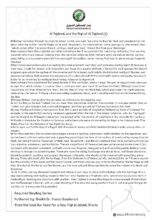Wage Increases in Syria

Introduction:
Different economic theories address the issue of wage increases from various angles. For example, classical growth theory suggests that economic growth can lead to an increase in income, thereby increasing consumers’ purchasing power. New classical theories focus on the importance of labor, capital, and technology in achieving economic growth. Modern economic theories discuss how technological advancements and e-markets can change the dynamics between producers and consumers, affecting supply and demand forces and thus wages. Additionally, some studies indicate that wage increases can occur without causing price hikes if accompanied by an increase in production. Some theories highlight the importance of planning and diversifying income sources to improve wages. Therefore, it can be said that increasing wages in a country requires a multifaceted approach that includes economic growth, technological advancement, and economic policies that promote production and improve wages.
Productivity Theory:
This is the most common theory for increasing wages, centered around the concept of productivity. It proposes that wage increases should match productivity gains. When workers become more efficient and produce more, their wages can be increased without causing higher costs for the company. According to this theory, companies can offer wage increases based on productivity improvements, measurable through individual or collective worker performance. This means that wage increases are economically justified and sustainable in the long term because they reflect the real value workers add to the company. Furthermore, modern theories suggest that investing in training and skill development can lead to productivity increases, thus increasing wages, emphasizing the importance of innovation and technology in boosting productivity and improving wages.
However, there are economic theories that oppose the productivity theory regarding wage increases. For instance, some theories suggest that focusing solely on productivity may overlook other important aspects such as labor demand, which can also affect wages. Other theories, like Keynesian theory, discuss the role government policies and interventions can play in the economy to stimulate aggregate demand, which in turn can lead to wage increases. Additionally, liberal socialist theory suggests wages can be increased through different profit distribution methods, such as employee bonuses or public funding, rather than relying solely on productivity. The moral hazard theory cautions that financial incentives should be granted carefully to avoid encouraging harmful behaviors. These theories reflect the diversity in economic thought and suggest there is no absolute answer to how to increase wages, but a variety of factors and policies must be considered.
Keynesian Theory:
Developed by British economist John Maynard Keynes during the Great Depression in the 1930s, it relies on the fundamental idea of government intervention to achieve economic stability, opposing the concept of an open market and Adam Smith’s school of thought. This theory focuses on aggregate spending in the economy and its effects on production, employment, and inflation, considering it a macroeconomic theory that views aggregate demand as the main driver of economic growth. According to Keynes, governments can influence aggregate demand through policies like increasing government spending and reducing taxes to stimulate the economy and combat unemployment, especially during economic downturns. Keynes believed the economy does not naturally tend towards full employment and may need interventions to achieve balance and prevent economic crises. The Keynesian theory is significant for providing a new explanation for the Great Depression and inspiring new economic policies aimed at preventing such crises in the future.
But how can Keynesian theory be used to improve wage levels? The theory suggests the government can play an active role in the economy by stimulating aggregate demand, which can lead to increased production and employment. When the government increases public spending or cuts taxes, it can boost consumer and investment spending, enhancing economic growth and creating more jobs. According to Keynesian theory, improving aggregate demand can break wage stagnation by raising the minimum wage for workers, allowing them to spend more on basic consumer goods. This increased spending can lead to a positive cycle that boosts economic growth and improves wage levels. Additionally, the theory indicates that reducing wages is not necessarily the solution to unemployment because it could lead to decreased spending and, consequently, lower aggregate demand, resulting in reduced demand for labor. Therefore, the Keynesian theory supports the idea that improving wages can be part of a broader strategy to stimulate the economy and achieve full employment, often requiring changes in existing policies and legislation. These changes include labor law reforms, new wage policies, tax adjustments, and economic incentives. Legislative reforms may also involve improving social safety nets, promoting wage equality, and encouraging investment in training and skill development to increase productivity. In some cases, reforms may include tax policy changes to relieve the working classes and improve their purchasing power.
Implementing Keynesian theory may require changes in fiscal and monetary policy to increase government spending and stimulate aggregate demand, potentially leading to improved wages and employment. However, these changes must be balanced and well-thought-out to ensure economic stability and social justice. The Keynesian theory encourages government intervention in the economy, which may include raising wages in some cases. Now, is raising wages positive? A study -referenced- on increasing the minimum wage showed results contrary to previous beliefs about the effects of minimum wages. Notably, the study suggested that increasing the minimum wage did not raise unemployment rates; employment did not decline in areas where the minimum wage increased compared to neighboring areas where it did not. In fact, employment slightly improved in some areas covered by the study where wages increased, supporting the hypothesis that minimum wage increases can simultaneously raise wages and employment.
The study also found that increasing the minimum wage coincided with price increases for targeted industry products, slightly exceeding the cost increase share. The rise in product prices was due to adjustment measures taken by production institutions to cope with wage increases, including adjustments in product pricing mix or improving and modifying the quality of services and products.
The question then arises, is it possible to apply this theory in northern Syria? The application of Keynesian theory may be complicated due to several factors:
First, the economic situation in northern Syria faces significant challenges, including ongoing conflict, high input costs, and water scarcity, negatively impacting the economy. Additionally, fuel shortages could weaken manufacturing, disrupt transportation, and services due to strained relations with western Syria.
Second, Keynesian theory relies on the ability to control economic policy, such as taxes and government spending, which may be challenging to implement effectively in a conflict context.
Third, wage increases could have unintended effects; for instance, it might lead to inflation if not balanced with an increase in production.
Therefore, while Keynesian theory can be a useful tool for understanding the economy, its application in northern Syria would require a complex analysis of local and specific economic conditions. However, it is conceivable that this theory could be utilized in the issue of wage increases to halt economic deterioration.
Conclusion:
Wage increases may have both positive and negative impacts on the economic situation in northern Syria:
On the positive side, raising wages could improve workers’ living standards and increase purchasing power, potentially supporting domestic demand and stimulating economic growth.
On the negative side, wage increases could raise costs for companies, leading to higher prices or reduced job opportunities. Additionally, there might be unintended effects such as inflation.
However, the final impact of wage increases depends on many factors, including the economic and political context, and the industrial sectors affected.
Therefore, the decision should be evaluated based on specific local and economic conditions.
To this end, the Syrian Future Movement could recommend the following:
- Paying exceptional attention to the issue of wage increases through government intervention, enforcing it as a reality for official, organized, or freelance professions, thereby helping to inject more money and improve the region’s economic level economically.
- Considering this a temporary solution until transitioning to a comprehensive solution for all of Syria.
- Conducting practical studies on how to start raising wages in the region and planning to prevent violations of the minimum wage standards.
Ammar Al-Amouri
Economic Office
Research and Studies Department
Studies
Syrian Future Movement (SFM)
References:
- Minimum wages raise employment (alarabiya.net)
- Study: Salary increases and their correlation with price hikes.. 7 suggestions to exit the economic decline | Economy2Day
- 10 Wage Theories (iedunote.com)
- Keynesian Theory and the History of Keynesian Economics | Borsaat (borsaat.com)
- The increase in salaries and its impact on improving purchasing power and the standard of living in Algeria | ASJP (cerist.dz)
- Global Wage Report 2020/21: COVID-19 and wages – ILO Publications






